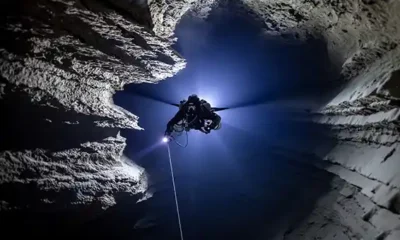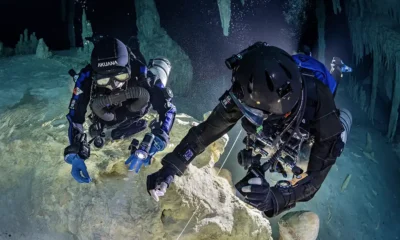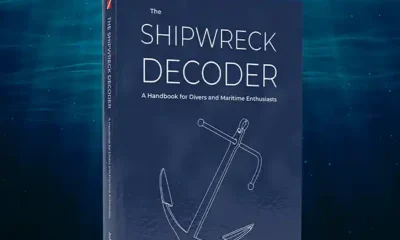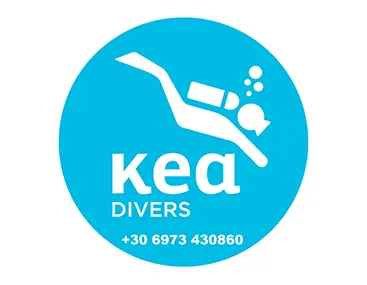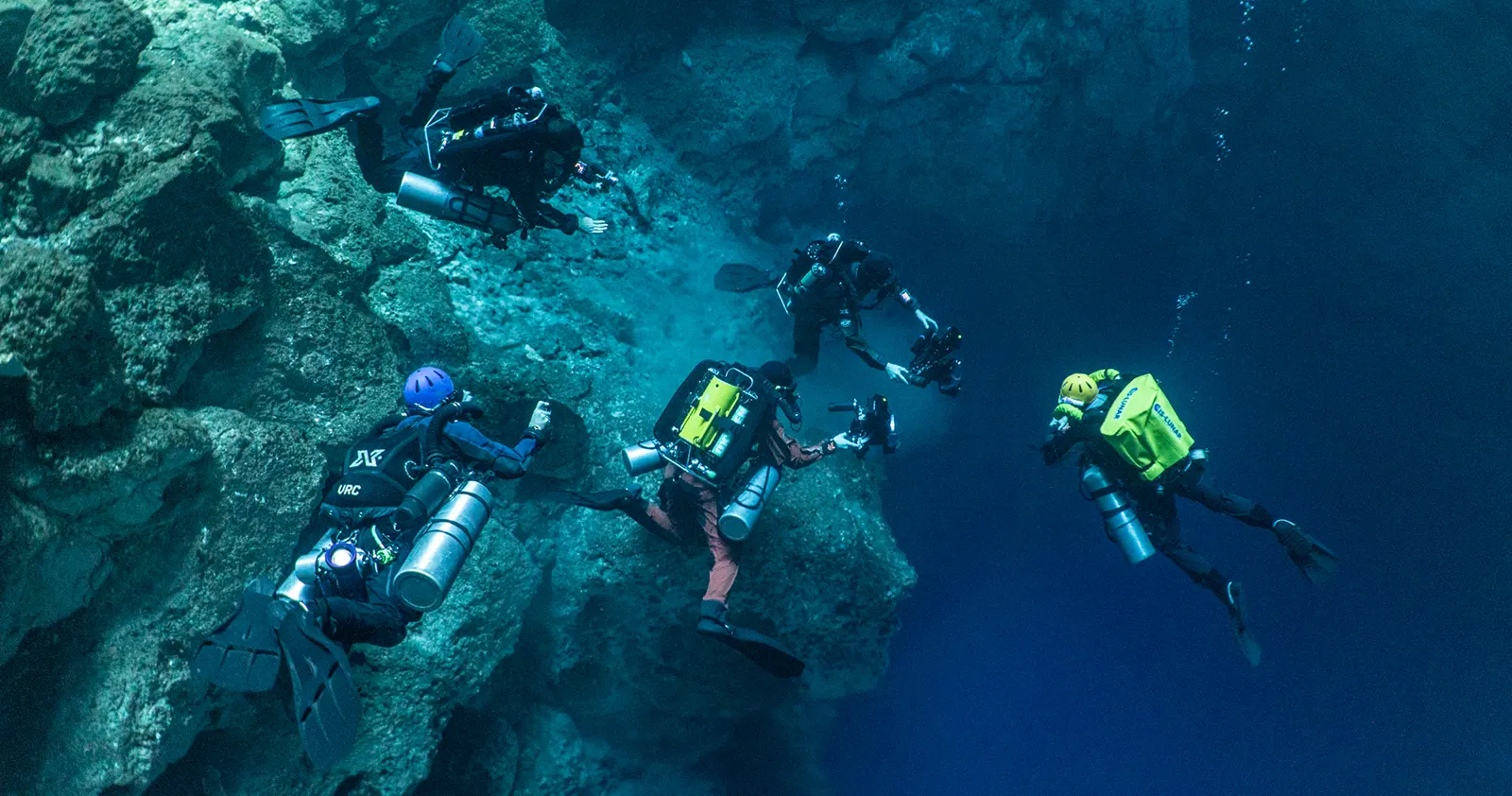

News
Inside “Diving Into The Darkness”
by Nays Baghai. Lead image courtesy of Tom St. George. Other images courtesy of Running Cloud productions unless noted.
Waves are being made in both the film and dive industries by Nays Baghai’s new feature documentary Diving Into The Darkness, which follows celebrated cave diving explorer, Dr. Jill Heinerth. More people have been to the moon than the places Jill has explored, and her list of accomplishments as a pioneer in diving, exploration and underwater filmmaking are innumerable.
Jill’s inspiring career is chronicled in Diving Into The Darkness, written, directed and edited by 26-year old Nays Baghai. Based in Australia, Nays set a new precedent amongst filmmakers by becoming the first feature film director to be certified to cave dive on a rebreather and lead an elite team of technical divers into passages far beyond the limits of recreational divers and traditional film crews.
The efforts of Nays and his teammates paid off when the film had its world premiere at the Academy Award-qualifying Santa Barbara International Film Festival. On Feb 17, it was announced that Diving Into The Darkness won the Best Documentary Award, and that the world premiere was the first of many sold out screenings. Although negotiations with distributors and festivals are still in their nascent phase, there is no doubt this is a film to watch out for. Here Nays answers the questions everyone’s asking about his film and what was involved in bringing it to life.
How did Diving Into The Darkness begin?
In March 2017, I attended OzTek for the first time. At the time, I was a film school student and did not know a single soul in the dive industry. As fate would have it, one of the first people I met was Jill Heinerth. But it wasn’t until I saw her presentation on a cave diving expedition to Cuba that I realised just how eminent and accomplished she was. She is such a warm, generous person that we ended up talking for half an hour after the show and over the next few years she became a close friend and a mentor.

Meeting all these incredible technical divers at OzTek made me think about what were their motivations behind taking such breathtaking risks and how I could explore that question as a filmmaker. My initial idea was to create a documentary series centred on the psychology of the world’s best divers, but by the end of 2021, I decided to focus solely on Jill’s story through a documentary feature film instead. At that point, Jill and I knew each other well enough that when I asked her if she was keen to adapt her autobiography, Into The Planet, into a feature film with me, her response was an immediate yes
Were you a technical diver before starting the project?
Yes; I had gotten certified as a JJ-CCR rebreather diver around when I was 24, and surprisingly, I acclimated to it fairly quickly. However, although I was an experienced single tank diver beforehand with a few logged dives in sea caverns, I had zero cave and mixed gas diving experience prior to filming. When I realised that bringing Jill’s story to life meant that pretty quickly I would have to get certified as a cave diver, which meant I would have to log a lot of rebreather dives and defeat even the slightest traces of claustrophobia. But, my dislike of being a lazy armchair director—along with the novelty associated with the challenge—fuelled my motivation to make it to the end.

What was the hardest thing about becoming a cave diver?
I did my basic cave course in Mount Gambier, South Australia, where the water rarely rises above 15°C/59ºF. When I did the stress test and had my mask ripped off my face, the shock of the cold water hit me like a brick to the head, and it became clear this was unlike anything I had ever dealt with in terms of stress management. Fortunately, a quote from Jill echoed in my brain, which eventually led me to pass the test—“Survival doesn’t have to be pretty; only efficient.”
The other challenging thing was that as soon as the course was over, I was immediately whisked into the duties of a director and had almost no time to build up my cave CCR experience. I was juggling a lot of tasks—scouting locations, communicating, nominating camera positions—whilst diving on my JJ in fairly shallow water and way beyond the reach of sunlight. Fortunately, the adjustment period was not as steep as I anticipated, and I was very lucky to be surrounded by a team of world-class cave divers from whom I felt comfortable asking for advice.

What made filming so difficult?
Shooting underwater is challenging enough, but doing so in the darkness of a cave with a crew of six increases the difficulty tenfold. To my knowledge, no other feature film director had ever led a CCR-only crew deep into underwater caves to direct such detailed dramatic scenes, so there wasn’t exactly a rulebook for me to follow. Fortunately, our lead cinematographer in Mexico, Janne Suhonen, who directed the short film Dive Odyssey, was familiar with a lot of the problems we would later run into, so I knew that his experience was an excellent resource to draw from whilst we were preparing for filming. Some hurdles we constantly faced included limited underwater communication, intricate shots, finicky lighting, coordinating teams, coaching performances, and all the environmental factors of shooting in caves.
To help memorise and absorb the shots we needed to get done for each scene, we followed a particular routine every morning before diving. Jill would give a brief description of what actually happened in real life for any given scene, while I would describe the general and specific images (and other elements) I wanted for the scene, and Janne would interpret it all by drawing his own personal storyboards and shot lists, which I would approve before heading into the water. Once submerged, we worked through each shot one by one, communicating through our rebreathers whenever necessary.
On top of all that, the narrative of the film spanned four decades and had a very layered chronology to follow. This presented even more complexities in terms of gear and wardrobe. To help combat this, I prepared a 100-page encyclopaedia that analysed each scene and identified the year, the gear/wardrobe, the cave and other details that would help the crew distinguish it and keep track of what we were doing. There were many other logistical and creative difficulties we experienced during filming that could constitute a movie of their own!

How did you mitigate the risks?
All of us on the dive team shared a unanimous attitude towards risk management—no shot is worth anyone’s life—and that whatever risks we take have to be thoroughly planned out. To help eliminate the dangers, we needed hindsight. That came from doing extensive research in advance about the dive sites, how many shots we would do per dive, how we would periodise rests into the overall schedule, and what kinds of hazards we had to account for.
For example, we wanted to depict Jill’s exploration of the deeper sections of The Pit, which drop well into the hypoxic trimix range below 100m/328 ft. Although all of us were qualified to dive on trimix, we decided that the risks of filming that deep were too great, and the difficulties associated with costs and logistics sealed the decision. Instead, we substituted specific sections in other cenotes that were much shallower, but visually comparable to what we wanted to show.
We made quite a few executive safety decisions whilst shooting in Mexico, from capping the swimming distance from the entrance to a maximum of 20 minutes, to using a skeleton crew (ie. cameraman, talent, safety diver) for the smaller caves where the full crew of six wouldn’t work. We also established a very honest atmosphere on set and weren’t afraid to abruptly end a dive if anyone was concerned.

How did technical diving influence your mindset as a filmmaker?
I was pleasantly surprised by how much my experience as a rebreather diver influenced my style as a director. If you’ve ever taken a CCR course, you will know that diving without bailout tanks is a recipe for disaster, as is not doing a thorough pre-dive inspection for your unit. That detail oriented mindset of taking every possible risk/failure point/scenario into account and identifying contingencies completely influenced my style as a director who had to deal with logistical and tactical problems every single minute.
However, the other side of that coin is that even if you are the most meticulous, safety-conscious diver, you cannot eliminate risk entirely, especially if you are diving into uncharted territory and pushing the limits of what is possible. That lesson was certainly applicable to the creative process of the film, and it required a lot of mental strength to deal with the challenges ahead.
During some of the the more challenging days in the editing process, I would jokingly remind myself—“If you can survive being wedged in the two foot tall squeezes of Minotauro and Dos Palmas in total darkness, then you should have what it takes to push on through with this creative challenge!”

What was it like working with such an icon like Jill?
Simply put, Jill is the best collaborator and professional I have ever had the privilege of working with. Part of what made her such a delight to work with was her fluency of the film-making process on both sides of the camera, which made it stress-free to communicate my vision and to problem-solve with her. More than anything, she had so many admirable qualities—enthusiasm, energy, stamina, punctuality, creativity, determination, level headedness, and experience—that had such an osmotic effect on the crew. The environment amongst the team was a very collaborative, democratic one, where the goal was to feel like one collective mind in pursuit of the same goal. In many ways, the experience was more comparable to an expedition than a film set.
What was the best dive of the whole shoot?
In terms of the best shooting day, I would have to nominate the final day of principal photography in the Poor Knights Islands in New Zealand. We had just lost nearly a whole week of filming due to Cyclone Gabrielle, but the day before we were due to leave, the weather finally improved, and we raced across the surgy waters to dive and shoot. When we dived in, the water was crystal clear and full of fish, and we immediately got to work without a word, getting shot after shot. I couldn’t believe how privileged I felt to share the water with some of the world’s best divers and how our rebreathers afforded us so much freedom in filming underwater. Although that day only amounted to less than a minute in the final cut, the fact that the last day of shooting also happens to be the final frames of the film is a nice coincidence that reminds me of some of the best moments shooting the film.
However, the best non-shooting dive was one that I did with my safety diver/guide, Arja Hintsala, in the Tajma Ha cave system before the full crew arrived in Mexico. I had to tackle many environmental obstacles that initially scared me—shallow water, sharp descents, squeezes, long distances, fragile bottoms, you name it. But I forced myself to take it in stride and swim as best as possible. By the time we made it past the Room Of Reflections and made it into one of the biggest rooms of the cave, the water was cobalt blue, and we were in the midwater column, completely surrounded in what was a surreal, cosmic environment straight out of a science fiction film. I remember thinking, “Oh, this is why people cave dive!” Echoes from various Pink Floyd songs (no pun intended) reverberated in my brain as I soaked in this enthralling sensation and appreciation for the sport.

What are your hopes for this film in the dive community?
I would love for the dive community to feel like one of their own made something that we can all collectively be proud of because of how the film strives to embody the spirit of cave diving.
As someone who is both a tech diver and a former freediving instructor, I have witnessed how both of these sports have been unfairly maligned and inaccurately misrepresented by the media as adrenaline sports performed by daredevils on suicide missions. I particularly cringe whenever big budget feature films take a sensationalist approach to the source material by exaggerating the risks and omitting key details in the interest of a thrilling story.
I feel very privileged that my positioning between the two worlds of diving and film affords me the chance to help bring a more authentic perspective to underwater storytelling. When you go to see this film, I offer you my guarantee that we have gone the extra mile to ensure the story you see accurately represents both Jill’s life as a diver and the soul of cave diving.
Where and when can people see the film?
We’ll be on the film festival circuit until the end of the year, and we are organising some upcoming screenings in Canada, Mexico, the UK, Australia and New Zealand—all of which will be announced shortly. Negotiations with streaming platforms are still underway—we’re aiming to have the film available online as soon as possible. For those who are curious, I encourage you to subscribe to the film’s website to stay tuned for further updates!
DIVE DEEPER
InDEPTH: The Who’s Who of Sidemount: Jill Heinerth
YouTube: New Book – Into The Planet – My Life as a Cave Diver
Movie Maker: Diving Into the Darkness Follows Cave Diver Jill Heinerth Far Below the Surface of Our Planet

Nays Baghai is an independent filmmaker and underwater creative from Sydney, Australia. A graduate of Australia’s national film school AFTRS, Nays’ feature film debut as a director, Descent, won the 2020 Sydney Film Festival, and is now streaming on Amazon Prime ANZ. His second feature, Diving Into The Darkness, won the 2024 Santa Barbara International Film Festival. In addition to his long form work as a director and editor, Nays has also won 30 awards for his short-form and photography work. His portfolio of clients includes Sony, Rolex, Deloitte, SBS, ScubaDiver Magazine and many more. As an underwater cinematographer, Nays holds a wide variety of diving certifications that enable him to operate in environments inaccessible to traditional film crews. He can be reached at: n@runningcloudproductions.com
























